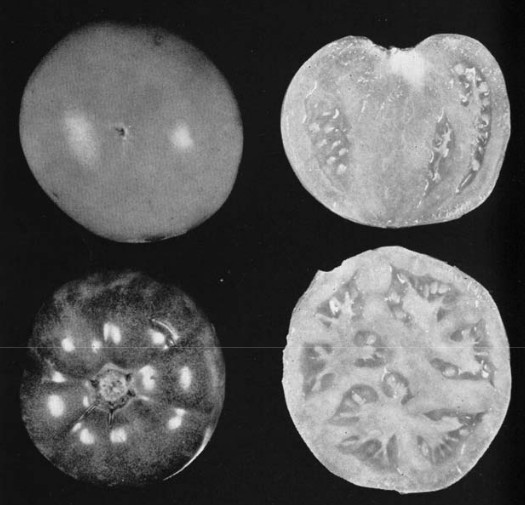 Variété précédente
Variété suivante
Variété précédente
Variété suivante
 Variété précédente
Variété suivante
Variété précédente
Variété suivante
Retour à la page "Passion tomate"
mise à jour le : 11-05-2020
Early Baltimore OP
Variété citée en 1936 dans l'étude "New Wilt-Resistant Tomato varieties for field and greenhouse
Auteur :W. A. Huelsen de l'Université de l'Illinois. College of Agriculture. Agricultural experiment station and service in agriculture and home economic.
Sélection à partir de la variété "Indiana Baltimore"
Obtention W. A. Huelsen probable en 1926
Variété originaire des USA.
Origin. Selected originally in 1926 for resistance to Fusarium wilt out of a
field of Indiana Baltimore badly infected with Fusarium wilt. Probably an
accidental cross or a mutation. Maturity. A second early type, maturi1"1g along
with Pritchard and Prairiana. Vine type. Intermediate in size, smaller than
Indiana Baltimore; foliage finer cut and growth habit more decumbent. Blossoms
set early and rather freely. No trouble has been experienced with excessive vine
growth. Fruits. Red, smooth, deeply oblate, small scar, small core, shallow
basin at stem end, solid and meaty with a thick rind. Seed cells vary from four
to many. Early Baltimore is only a moderate seeder. Fruits are about the same
size as Marglobe. Cracking varies with the season bJ.1t is mostly of the
concentric type and shallow. The fruits retain most of the desirable characters
of the Indiana Baltimore but mature a week or more earlier. Yields per acre (U.
S. No.1 and U. S. No.2) 1930-Early Baltimore, 5.37 tons; Marglobe check, 2.38
tons. 1931-Early Baltimore, 7.82 tons; Greater Baltimore check, 2.18 tons.
1932-Early Baltimore, 9.39 tons; Marglobe check, 9.09 tons. 1934-Early
Baltimore, 7.57 tons; Marglobe check, 4.30 tons. 1935-0n eroded brown silt loam,
low in fertility Early Baltimore, 6.51 tons; Pritchard check, 6.45 tons.
Duplicate test in 1935 on heavy black clay loam, high in fertility Early
Baltimore, 7.17 tons; Pritchard, 6.62 tons. That Early Baltimore is particularly
adapted to the midwestern conditions of extreme heat and dry weather is
indicated by its superiority to the check varieties in the adverse drouth years
of 1930, 1931 , and 1934. In normal years such as 1932 and 1935 the yield was
equal to Pritchard, Marglobe, or Greater Baltimore. Use. Early Baltimore is
excellent for market purposes and retains the high quality and quick, even
ripening which make Greater Baltimore so popular for canning. The tests so far
have shown that Early Baltimore may be grown on highly fertile soils without
danger of excessive vine growth. On poorer soils its performance is satisfactory.
7